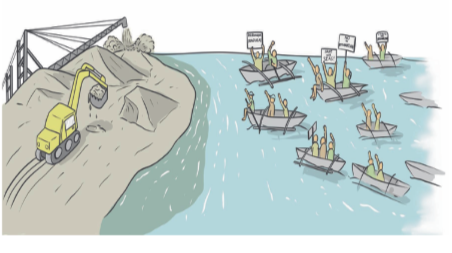
The term ‘informal settlers’ or the more derogaroty, ‘squatters,’ are often used by the reactionary government to describe poor communities in urban areas. However, who is really ruining the land and driving longtime residents out of the cities? In fact, foreign companies and their local partners are the real squatters.
This is what happened on Negros Island where private companies owned by big compradors and bureaucrats attacked urban poor and coastal communities. Behind the old promise of “development” and “economic opportunities,” big businesses have destroyed the lives and livelihoods of thousands of families to implement the reclamation project where in time buildings, commercial centers, ports, and others will be built based on neoliberal policies.
In the barangays of Pahanocoy and Banago in Bacolod City, the objective of projects pushed by Jerry Sy and Engr. Andre Taculod is land reclamation and establishment of businesses. Sy intends to build several malls, ports, shipyards and other buildings. However, these projects will affect no less than 10,000 individuals living in the area.
Meanwhile, Mayor Remulla wants to turn Brgy. Tinago in Dumaguete City into a stadium with an Olympic-sized swimming pool. Remulla hopes to hold the Southeast Asian Games in Dumaguete in the future. Thousands of houses are threatened to be demolished. At the start of the reclamation, fisherfolks needed to detour their small boats because local government has blocked the way for the reclamation.
Nong Jasper, a fisherman in Banago, has no regular income because fishing relies on the weather. Usually, his daily income of ₱300 is not enough for the basic needs of his three school-aged children.
The situation of Manang Myrna who is a sidewalk vendor living in Pahanocoy for five years now is similar. On a good day, she earns ₱200 from selling fish by the roadside. But her income is not sufficient to buy food for her family, and so she is forced to loan money to survive.
Mercy, from Barangay Tinago, is a contractual government employee. She adjusts the daily expenses according to the ₱10,000 she accumulated from her minimum wage and from the income of her husband as a full-time fisherman every month. The money is already spent after paying utilities like water and electricity bills, and buying their daily needs.
Local residents are full of worry on how the local government sugarcoats reclamation projects that will affect the residents. If these projects are fully carried out in the cities of Bacolod and Dumaguete, the likes of Jasper, Myrna, Mercy and thousands of other residents will lose their jobs because their source of livelihood for over a decade will be destroyed.
Moreover, these projects have caused alarm among environemntal groups due to the extent of the damage to coastal flora and fauna. The “Smart City”, another project in Dumaguete proposed by EM Cuerpo Inc. that spans 174 hectares will cause total destruction to corals, mangroves, and four marine protected areas.
Common to these projects is the absence of the formal process of public consultation and transparency to the people, hastening the implementation of business interests. Government institutions like the DENR and LGUs are often negligent and conspire with big companies. They secretly pocket kickbacks and make other corrupt schemes to ensure that these projects are not impeded by the people’s resistance.
However, the residents of Brgy. Banago and Pahonocoy in Bacolod and Brgy. Tinago in Dumaguete along with the majority of the people have a united call: “Resist neoliberal-ization!,” “Reject reclamation!” and “Protect our natural resources!” People’s organizations like the No to 174 Alliance, Save Tinago Alliance, and Bacolod Against Reclamation Movement have brought together urban poor, church workers from various congregations, scientists, environmental and human rights defenders, students, lawyers, and other professionals to unite and call for resistance against the reclamation and neoliberal aggression that brings harm to coastal coastal communities and the environment.
